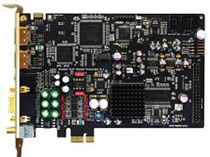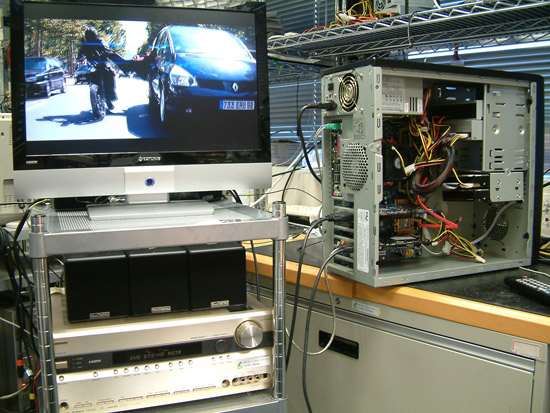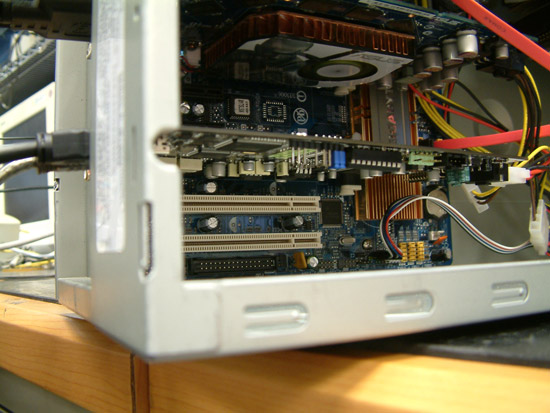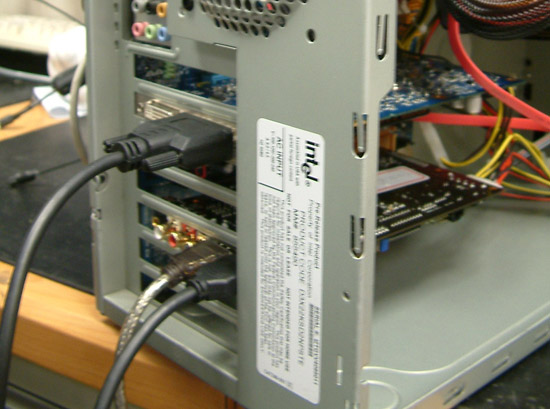Understanding 8-channel LPCM over HDMI: Why it Matters and Who Supports it
by Anand Lal Shimpi on September 17, 2008 2:00 PM EST- Posted in
- GPUs
The Bandaid: The HDMI Sound Card
Ha! I lied; there's more.
No GPUs released in 2008 will support this protected audio path and thus we won't be able to get TrueHD/DTS-HD MA support from a GPU anytime soon. There is another option however: HDMI sound cards.
A couple of companies are working on sound cards with a built-in HDMI repeater, meaning there's an HDMI input, some logic to add data to the HDCP encrypted signal, and an HDMI output.
Your GPU would handle all video decoding and it would send its decoded but HDCP encrypted signal over HDMI, but instead of going to your display (or receiver or pre-processor) it would go next door to your sound card over HDMI (3dfx dongles anyone? At least these are lossless since they are digital signals... oh, hush, Monster).
The sound card would have an audio codec capable of ensuring a protected audio path and would handle all of the audio decoding/bitstreaming in the system. The audio from the sound card and the video from the HDMI input on the sound card would be combined, the HDCP repeated, and the new combined signal sent over HDMI to your receiver/display.
The HDMI spec allows for repeater support (as in devices that add something to an HDCP encrypted HDMI signal and pass along the new combined signal), so the HDMI sound card is really no different than sending HDMI to a receiver and then to your display. There should be no loss in quality or any other negative side effects if implemented properly.
ASUS and Auzentech are both working on these HDMI sound cards that should solve all of our HTPC problems. While both were supposed to be available over the summer, driver and software delays have pushed back both release dates to the last few months of 2008.

The Auzentech card
We have proof that the ASUS card was fully functional at Computex 2008; below are shots of the Xonar HDAV bitstreaming DTS-HD MA to an Onkyo receiver:

The test system

The Card

DVI to HDMI input, then HDMI output

It works!
We’ve got the ASUS card in house and are simply waiting for final drivers before testing it, so expect a review in the not too distant future.
I mainly wrote this quick guide to have something to link back to whenever I list 8-channel LPCM audio over HDMI as a feature. It’s not a typical PC feature like DirectX 10.1 or supporting SSE4, so it needed a little more of an explanation. And there you have it.










53 Comments
View All Comments
nubie - Monday, September 22, 2008 - link
How does the audio get to the receiver?If the HDMI cable leaves the video card, and then travels to the audio card, and then to the TV where the audio is sent to a tuner, or to the tuner where the video is sent to the TV, it starts getting freaking ridiculous in short order.
Wouldn't it be more logical to have an HDMI to go to the Audio device, and another to go to the TV? Is that even possible?
I am not currently interested in paying to have my equipment functionality reduced. Although I am still being effected:
I want to allow my mother to watch Netflix online on her TV, fine I think: I have a ti4200 and a nice little mATX Socket 754 system, that will play Netflix online just fine.
Except for DRM. DRM has decided that TV output on a ti4200 is "unprotected", thus if I even have a TV output enabled on the card all video playback in WMP11 is halted. Any other TV output card is fine, my 6200, 6100, 7300, 7900, ironically a geforce4 MX series will probably work, as the on-chip TV encoder is likely supported by the Same DRM equipped driver that the MX4000 uses.
They all pass the buck, Netflix claims it is Microsofts DRM at fualt, Microsoft passes the buck to nVidia for not supporting their DRM by writing a DRM driver for the ti4200 series. nVidia sits on its laurels and claims "that is a legacy product", while happily providing a DRM driver for the Geforce2 based (and now PCI-E supporting) Mx4000 cards.
All of this is an artificial block to me using my equipment in ways it fully supports on content I payed for.
And none of this has stopped the bit-torrenting of movies. In fact it has probably increased it, as people who have shelled out $30-40 for a DVD version of their favorite movie now shell out $50-60 for the Blu-Ray version, only to find that they need "new hardware" or they will have artificial restrictions placed on their technically capable hardware, but of course it is highly illegal to download a ripped version of that content (or even rip it yourself) so that you can play it on your hardware.
The public doesn't understand this, in fact they probably won't notice that their video signal is composite instead of HD, even if that is the whole reason for the existence of Blu-Ray. The movie companies still keep claiming that this is "to fight piracy", yeah right. As soon as the pirate distribution of any movie reaches 1 million(or even a thousand, or even 1 if it takes me a couple mouse clicks to get the pirated copy) downloads I would like my purchased content to be released from this draconian "copy" "protection".
Call it what it really is "usage protection". See this comic for an Orwellian perspective on the direction this could be heading :P http://www.xkcd.com/129/">http://www.xkcd.com/129/
How long until free content will not play on DRM players? What will the excuses be? Maybe: "It is cheaper to build and saves the customer money, after all their movies should all support DRM if they aren't Pirates"
Moo people, just watch out for that slaughtering plant.
danielmastia - Saturday, September 20, 2008 - link
I haven't read the article yet, but i looove the fact that the speakers on the diagrams are Bower & Wilkins. Love my speakersseefeel - Friday, September 19, 2008 - link
Being a person who has spent time in screening rooms watching and listening to soundtracks being assembled, I can tell you that studios don't spend money frivolously on things that have no meaning to the audience. In their minds, great sound = more engaging cinematic experience = more money. That Dolby D sounded as good as it did considering it was nothing more than 5 channels of low bit rate MP3 is pretty cool. Now with Dolby Tru HD and the variants we can hear the same quality as the D1 Master.I find it strange that the reaction from some can be best summarized as follows- you don't need it, wouldn't know what to do with it if you had it and besides, you could not hear it anyway because your hearing is damaged. Thankfully nobody in film sound community of any note feels the same. I might suggest this link to Dolby's website which has some great interviews with professionals involved in film sound and their views on a variety of topics. http://www.dolby.com/consumer/motion_picture/inter...">http://www.dolby.com/consumer/motion_picture/inter... Reading the interviews, I'm reminded of how sophisticated film sound is in it's ability to better engage us in the cinematic experience. For a great read on our hearing facility, I might suggest "This is your brain on music" by Daniel Levitin, which explains just how sophisticated our hearing actually is.
deeznuts - Thursday, September 18, 2008 - link
I used to be totally into HTPCs ... until I got my PS3. I know of the other uses for HTPCs (music, photos dvr etc.) but I just lost interest when I got the PS3 at launch. Criterion uses the PS3 as their reference BD player.Good enough for me.
geok1ng - Thursday, September 18, 2008 - link
Another seminal article by Anand! You did it again!This time i could not resist and took the liberty of posting a link to this article in a Brazilian HTPC forum: http://www.htforum.com/vb/showthread.php?p=1313156...">http://www.htforum.com/vb/showthread.php?p=1313156...
"PC audio is to audiophiles what militar justice is to Justice!"
How long will my statement be truth?
HelToupee - Thursday, September 18, 2008 - link
2) they only supported a maximum of 6-channels of audio (aka 5.1 surround sound: right, left, center, left surround, right surround and LFE/sub channel).Umm.. There is a variant of DTS that supports 6.1. It's called DTS-ES. It hasn't been used much, but I got a good deal on a compatible receiver for the same price as one that only did 5.1, so I went for it. The only DVD's I own that actually have a DTS-ES track are the Lord of the Ring trilogy. Most 7.1 capable receivers will decode DTS-ES also and play the rear center channel through both the rear right and rear left speakers.
adder - Thursday, September 18, 2008 - link
why cant these souncards have a 7.1 ch analog out ,i.e they should output the fully decoded HD audios formats so that people who have a older receiver can enjoy HD audio.vignyan - Thursday, September 18, 2008 - link
When decoding, does the application also encrypt the Dolby Digital TrueHD or DTS-HD MA audio? If so, the same should be true while sending the LPCM audio. Either way (TureHD or LPCM), the data has to be put in the memory w/o any AES-128 encryption. The GPU support of PAVP comes with ability to decrypt the AES-128 encoded signals. Assuming the the gfx cards dont have the protected audio capability, the application must be putting the un-encrypted audio in the memory which has to be sent over HDMI channel after translating the audio into the HDMI specified format.Intel G45 supports HBR audio (>6.144 Mbps as with the Dolby Digital TrueHD or DTS-HD MA audio) with HDCP encryption. Previous versions of Intel chipsets did not have this capability. HBR, if i am not wrong, is introduced with 1.3a spec.
I am too poor to know if such features are enabled on the GTX2xx and ATI48xx... Send me a sample of both and i will let you know... ;)
dryloch - Wednesday, September 17, 2008 - link
I lucked out at a store called Brandsmart,they had that receiver on Open box for under 200 because the remote was missing. This is my second Onkyo and I will never buy anything else. For the money they charge Onkyo gives you a very feature rich unit with very clear and loud sound. When I compare the sound coming out of an 80 watt a channel Onkyo to a supposed 120W Sony it is obvious that Sony is trying to pull a fast one.Zak - Wednesday, September 17, 2008 - link
And I'm not buying into this BS, but a lot of people will, for bragging rights. And all the encoding/copy protection is a big turnoff for me. I just don't see HD in my near future. As many posters pointed out already: I don't want to be punished by Hollyw$$d for being a paying customer. Anyway, I stopped even buying DVDs after Shrek2 when I found out that it has around 5 minutes of unskippable bullshit. I rent them from Netflix or download for free. I'd love to have my own collection of movies but with all the copy protection, offending FBI, CIA, WTF warnings, discs are not worth buying. I'd pay for a video disk that I can put into my player and get to the main menu under 5 seconds without having to watch crap and skip 5+ previews I don't care for. AND I want to be able to rip my fav movies to my hard drive so they're instantly available on my HTPC.Z.